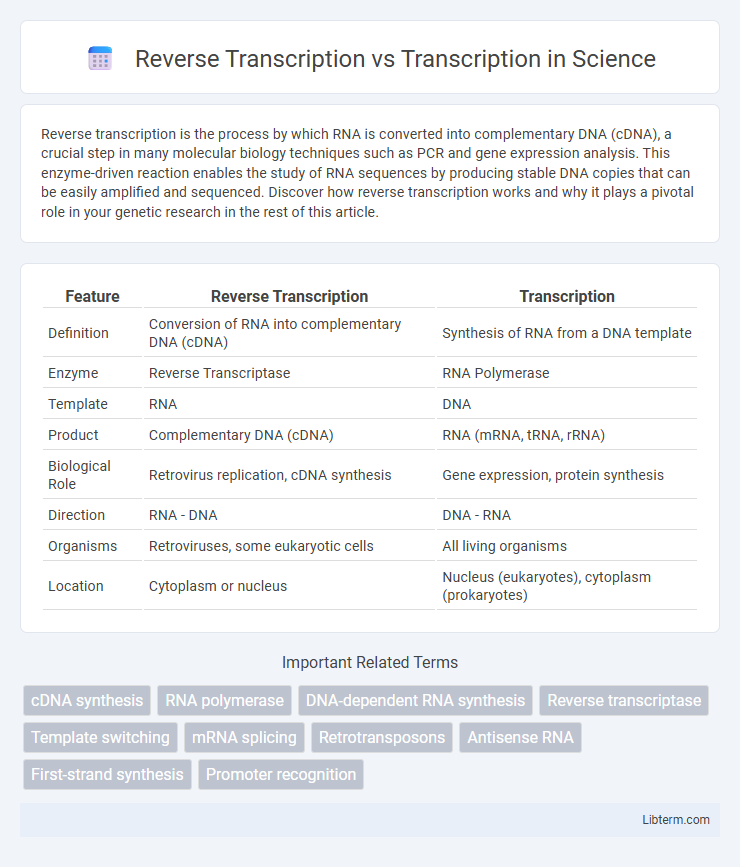Reverse transcription is the process by which RNA is converted into complementary DNA (cDNA), a crucial step in many molecular biology techniques such as PCR and gene expression analysis. This enzyme-driven reaction enables the study of RNA sequences by producing stable DNA copies that can be easily amplified and sequenced. Discover how reverse transcription works and why it plays a pivotal role in your genetic research in the rest of this article.
Table of Comparison
| Feature | Reverse Transcription | Transcription |
|---|---|---|
| Definition | Conversion of RNA into complementary DNA (cDNA) | Synthesis of RNA from a DNA template |
| Enzyme | Reverse Transcriptase | RNA Polymerase |
| Template | RNA | DNA |
| Product | Complementary DNA (cDNA) | RNA (mRNA, tRNA, rRNA) |
| Biological Role | Retrovirus replication, cDNA synthesis | Gene expression, protein synthesis |
| Direction | RNA - DNA | DNA - RNA |
| Organisms | Retroviruses, some eukaryotic cells | All living organisms |
| Location | Cytoplasm or nucleus | Nucleus (eukaryotes), cytoplasm (prokaryotes) |
Introduction to Transcription and Reverse Transcription
Transcription is the process by which RNA is synthesized from a DNA template, involving RNA polymerase to produce messenger RNA essential for protein synthesis. Reverse transcription, performed by reverse transcriptase, converts RNA back into complementary DNA (cDNA), a key step in retroviral replication and molecular biology techniques. These fundamental processes enable genetic information flow between DNA and RNA, facilitating gene expression and viral integration.
Understanding the Basics: What Is Transcription?
Transcription is the biological process where RNA polymerase synthesizes messenger RNA (mRNA) from a DNA template, enabling gene expression. Reverse transcription, in contrast, involves converting RNA back into complementary DNA (cDNA) using the enzyme reverse transcriptase, primarily observed in retroviruses. Understanding transcription is essential for grasping how genetic information flows from DNA to RNA, forming the foundation of protein synthesis and cellular function.
Reverse Transcription Explained
Reverse transcription is the process by which RNA is converted back into complementary DNA (cDNA) using the enzyme reverse transcriptase, essential in retroviruses like HIV. Unlike transcription, which synthesizes RNA from a DNA template, reverse transcription allows viral RNA genomes to integrate into host DNA, facilitating replication and persistence. This mechanism underpins important biotechnological applications such as reverse transcription polymerase chain reaction (RT-PCR) for gene expression analysis and viral detection.
Key Enzymes: RNA Polymerase vs Reverse Transcriptase
RNA polymerase is the key enzyme in transcription, synthesizing RNA from a DNA template by adding ribonucleotides complementary to the DNA strand. In contrast, reverse transcriptase catalyzes reverse transcription by synthesizing complementary DNA (cDNA) from an RNA template, a critical process in retroviruses and certain molecular biology techniques. These enzymes differ fundamentally in substrate preference and directionality of information flow, with RNA polymerase facilitating DNA-to-RNA transcription and reverse transcriptase enabling RNA-to-DNA reverse transcription.
Biological Significance of Transcription
Transcription plays a crucial biological role by converting DNA sequences into messenger RNA (mRNA), which serves as a template for protein synthesis essential to cell function and organismal development. Unlike reverse transcription, which synthesizes DNA from RNA primarily in retroviruses, transcription enables the regulation of gene expression and is fundamental to cellular differentiation and response to environmental signals. The fidelity and control mechanisms in transcription ensure accurate genetic information flow and maintain cellular homeostasis.
Reverse Transcription in Molecular Biology
Reverse transcription is the process by which RNA is converted back into complementary DNA (cDNA) by the enzyme reverse transcriptase, a mechanism central to retroviruses such as HIV. This process is essential in molecular biology for creating stable DNA copies from RNA templates, enabling techniques like cDNA library construction and quantitative reverse transcription PCR (qRT-PCR). Unlike transcription, which synthesizes RNA from a DNA template, reverse transcription facilitates the study of gene expression by allowing the analysis of RNA sequences through DNA intermediates.
Major Differences Between Transcription and Reverse Transcription
Transcription is the process where RNA polymerase synthesizes messenger RNA (mRNA) from a DNA template, enabling gene expression in cells. Reverse transcription involves the enzyme reverse transcriptase converting RNA back into complementary DNA (cDNA), a crucial step in retroviral replication and certain molecular biology techniques. The major difference lies in the directionality: transcription reads DNA to produce RNA, while reverse transcription reads RNA to produce DNA.
Applications in Research and Diagnostics
Reverse transcription converts RNA into complementary DNA (cDNA), enabling analysis of gene expression and RNA viruses, crucial for applications like quantitative PCR and viral load monitoring in diagnostics. Transcription refers to synthesizing RNA from a DNA template, fundamental for studying gene regulation, messenger RNA profiling, and understanding cellular responses in research. Techniques utilizing reverse transcription are pivotal in identifying RNA-based diseases, while transcription-based assays facilitate investigation of transcriptional activity and epigenetic modifications.
Challenges and Limitations of Each Process
Reverse transcription faces challenges such as lower fidelity due to the error-prone nature of reverse transcriptase enzymes, leading to increased mutation rates compared to DNA-dependent RNA polymerases in transcription. Transcription is limited by the need for complex regulation and precise promoter recognition, which can be disrupted by mutations or epigenetic changes, resulting in aberrant gene expression. Both processes require optimal cellular conditions and cofactors, with reverse transcription being particularly sensitive to template RNA quality and transcription influenced by chromatin structure and transcription factor availability.
Summary: Transcription vs Reverse Transcription Comparison
Transcription is the process of synthesizing RNA from a DNA template, essential for gene expression, while reverse transcription generates complementary DNA (cDNA) from an RNA template, primarily used by retroviruses. Key enzymes differ: RNA polymerase mediates transcription, whereas reverse transcriptase drives reverse transcription. This fundamental distinction underpins techniques like RT-PCR for studying gene expression and retroviral replication mechanisms.
Reverse Transcription Infographic

 libterm.com
libterm.com